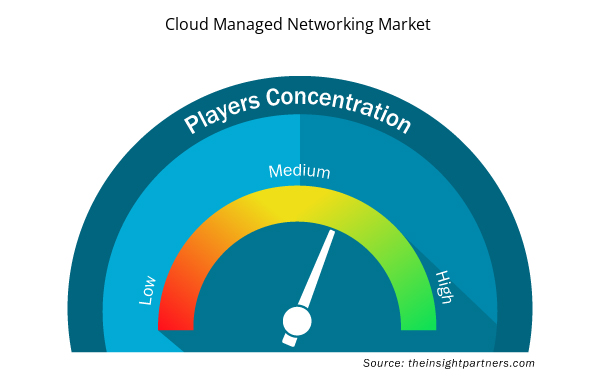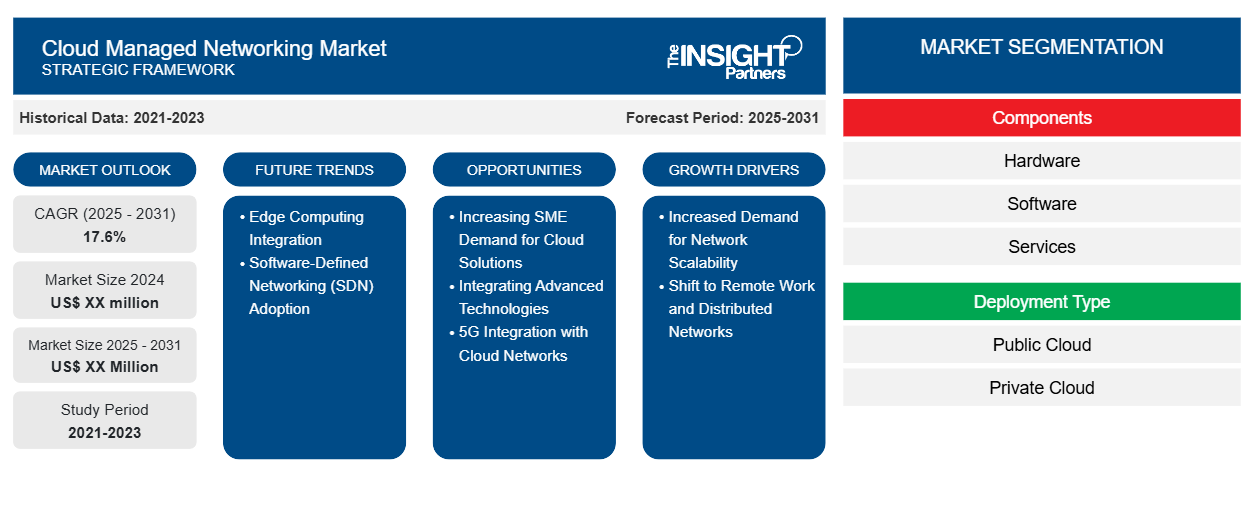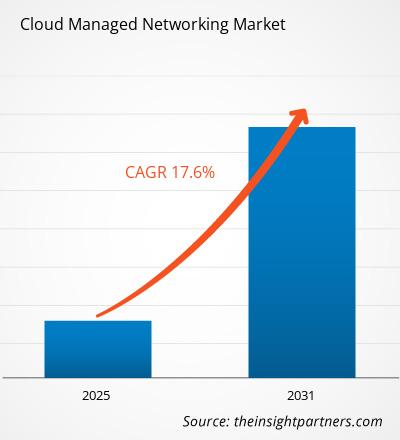Der Markt für Cloud Managed Networking soll von 2023 bis 2031 eine durchschnittliche jährliche Wachstumsrate (CAGR) von 17,6 % verzeichnen, wobei die Marktgröße von XX Millionen US-Dollar im Jahr 2023 auf XX Millionen US-Dollar im Jahr 2031 anwachsen soll.
Der Bericht ist segmentiert nach Komponenten (Hardware, Software, Dienste); Bereitstellungstyp (Public Cloud, Private Cloud); Unternehmensgröße (kleine und mittlere Unternehmen (KMU), Großunternehmen); Branche (Telekommunikation und IT, Einzelhandel, Medien und Unterhaltung, Bildungseinrichtungen, Sonstige). Die globale Analyse ist weiter auf regionaler Ebene und nach wichtigen Ländern aufgeschlüsselt. Der Bericht bietet den Wert in USD für die oben genannte Analyse und Segmente.
Zweck des Berichts
Der Bericht Cloud Managed Networking Market von The Insight Partners soll die aktuelle Landschaft und das zukünftige Wachstum sowie die wichtigsten treibenden Faktoren, Herausforderungen und Chancen beschreiben. Dies wird verschiedenen Geschäftspartnern Einblicke geben, wie zum Beispiel:
- Technologieanbieter/-hersteller: Um die sich entwickelnde Marktdynamik zu verstehen und die potenziellen Wachstumschancen zu kennen, damit sie fundierte strategische Entscheidungen treffen können.
- Investoren: Durchführung einer umfassenden Trendanalyse hinsichtlich der Marktwachstumsrate, der finanziellen Marktprognosen und der Chancen entlang der Wertschöpfungskette.
- Regulierungsbehörden: Zur Regulierung von Richtlinien und Überwachungsaktivitäten auf dem Markt mit dem Ziel, Missbrauch zu minimieren, das Vertrauen der Anleger zu bewahren und die Integrität und Stabilität des Marktes aufrechtzuerhalten.
Marktsegmentierung für Cloud Managed Networking
Komponenten
- Hardware
- Software
- Dienstleistungen
Bereitstellungstyp
- Öffentliche Cloud
- Private Cloud
Größe der Organisation
- Kleine und mittlere Unternehmen
- Große Unternehmen
Industrie
- Telekommunikation und IT
- Einzelhandel
- Medien und Unterhaltung
- Bildungseinrichtungen
- Sonstiges
Industrie
- Telekommunikation und IT
- Einzelhandel
- Medien und Unterhaltung
- Bildungseinrichtungen
- Sonstiges
Passen Sie diesen Bericht Ihren Anforderungen an
Sie erhalten kostenlose Anpassungen an jedem Bericht, einschließlich Teilen dieses Berichts oder einer Analyse auf Länderebene, eines Excel-Datenpakets sowie tolle Angebote und Rabatte für Start-ups und Universitäten.
- Holen Sie sich die wichtigsten Markttrends aus diesem Bericht.Dieses KOSTENLOSE Beispiel umfasst eine Datenanalyse von Markttrends bis hin zu Schätzungen und Prognosen.
Wachstumstreiber für den Cloud Managed Networking-Markt
- Erhöhte Nachfrage nach Netzwerkskalierbarkeit: Wenn Unternehmen wachsen, benötigen sie skalierbare Netzwerkinfrastrukturen, die wachsende Datenverkehrs- und Datenmengen bewältigen können. Cloud-verwaltete Netzwerke bieten flexible, bedarfsgesteuerte Ressourcen, um die Netzwerkkapazität ohne große Kapitalinvestitionen zu skalieren. Diese Nachfrage nach Skalierbarkeit fördert die Akzeptanz und ermöglicht es Unternehmen, Netzwerkressourcen effizient zu verwalten, die Leistung zu verbessern und die Komplexität der lokalen Verwaltung zu reduzieren.
- Umstellung auf Remote-Arbeit und verteilte Netzwerke: Der wachsende Trend zur Remote-Arbeit und der Bedarf an verteilten Netzwerken treiben den Markt für Cloud Managed Networking an. Cloudbasierte Lösungen ermöglichen es Unternehmen, Remote-Büros, Niederlassungen und Mitarbeiter zu verbinden und gleichzeitig eine sichere, effiziente und zentralisierte Netzwerkverwaltung zu gewährleisten. Dieser Wandel erhöht den Bedarf an verwalteten Diensten, die die Remote-Netzwerkverwaltung vereinfachen und die Zusammenarbeit verbessern.
Zukünftige Trends im Cloud Managed Networking-Markt
- Edge-Computing-Integration: Der Aufstieg des Edge-Computing beeinflusst den Cloud-Managed-Networking-Markt. Da Unternehmen Daten am Rande und damit näher an den Endbenutzern generieren, muss sich die Netzwerkinfrastruktur anpassen, um diese Anforderungen zu erfüllen. Cloud-verwaltete Netzwerke werden zunehmend in Edge-Computing-Plattformen integriert, um eine schnellere Datenverarbeitung, geringere Latenz und eine nahtlose Konnektivität über verteilte Umgebungen hinweg zu gewährleisten.
- Einführung von Software-Defined Networking (SDN): Software-Defined Networking (SDN) bleibt weiterhin ein wichtiger Trend im Bereich Cloud-verwalteter Netzwerke. SDN ermöglicht es Unternehmen, den Netzwerkverkehr zentral über Software zu verwalten, was mehr Kontrolle, Flexibilität und Agilität bietet. Durch die Entkopplung der Steuerungsebene von der Hardware ermöglicht SDN eine einfache Skalierung von Cloud-verwalteten Netzwerken und die Anpassung an sich ändernde Geschäftsanforderungen ohne die Komplexität der herkömmlichen Netzwerkverwaltung.
Marktchancen für Cloud Managed Networking
- Steigende Nachfrage von KMU nach Cloud-Lösungen: Kleine und mittlere Unternehmen suchen nach kostengünstigen professionellen Cloud-Diensten, um ihre digitale Transformation voranzutreiben. Für Anbieter, die maßgeschneiderte, skalierbare Lösungen anbieten, bietet sich daher eine riesige Marktchance.
- Integration fortschrittlicher Technologien: Der Einsatz von KI, maschinellem Lernen und Automatisierung in Cloud-Diensten bietet professionellen Serviceunternehmen die Möglichkeit, Dienste anzubieten, die die Datenanalyse, die Entscheidungsfindung und die allgemeine Cloud-Leistung verbessern.
- 5G-Integration mit Cloud-Netzwerken: Mit der Einführung der 5G-Technologie besteht die Möglichkeit, Cloud-verwaltete Netzwerke in schnelle 5G-Netzwerke mit geringer Latenz zu integrieren. Dies wird die Netzwerkleistung verbessern und neue Anwendungen in Bereichen wie IoT, autonome Fahrzeuge und Echtzeit-Datenverarbeitung ermöglichen. Cloud-verwaltete Netzwerke werden für die Optimierung der Leistung und Skalierbarkeit von 5G-Diensten von entscheidender Bedeutung sein.\",Wie hoch ist die erwartete CAGR des Marktes für cloud-verwaltete Netzwerke?Der Markt für cloud-verwaltete Netzwerke wird von 2023 bis 2031 voraussichtlich eine CAGR von 17,6 % verzeichnen.Welche treibenden Faktoren beeinflussen den globalen Markt für cloud-verwaltete Netzwerke?Die Komplexität der Bereitstellungen durch die Cloud und der Fokus auf die digitale Transformation sind die Hauptfaktoren für den Markt für cloud-verwaltete Netzwerke.Was sind die zukünftigen Trends des Marktes für cloud-verwaltete Netzwerke?Managed Services und Beratung werden in den kommenden Jahren eine bedeutende Rolle auf dem globalen Markt für cloud-verwaltete Netzwerke spielen.In welchen Formaten kann der Marktbericht geliefert werden?Der Bericht kann im PDF-/PPT-Format geliefert werden; wir können auf Anfrage auch Excel-Datensätze freigeben.Welche Optionen stehen für die Anpassung dieses Berichts zur Verfügung?Einige der auf Anfrage verfügbaren Anpassungsoptionen sind zusätzlich 3-5 Unternehmensprofile und länderspezifische Analysen von 3-5 Ländern Ihrer Wahl. Anpassungen müssen vor der endgültigen Auftragsbestätigung angefragt/besprochen werden
- da unser Team dies überprüfen und die Machbarkeit prüfen würde,
TIPRE00011695, Markt für Cloud-Managed-Services, Markt für Cloud-Managed-Services, 2024-2031, 2021-2022, CAGR von 14,0 % von 2023 bis 2031, XX Millionen US-Dollar im Jahr 2023, XX Millionen US-Dollar bis 2031, Der Bericht ist nach Servicetyp (Managed Business Services) segmentiert
Regionale Einblicke in den Cloud Managed Networking-Markt
Die regionalen Trends und Faktoren, die den Markt für Cloud Managed Networking im Prognosezeitraum beeinflussen, wurden von den Analysten von Insight Partners ausführlich erläutert. In diesem Abschnitt werden auch die Marktsegmente und die Geografie von Cloud Managed Networking in Nordamerika, Europa, im asiatisch-pazifischen Raum, im Nahen Osten und Afrika sowie in Süd- und Mittelamerika erörtert.

- Holen Sie sich die regionalen Daten für den Cloud Managed Networking-Markt
Umfang des Marktberichts zu Cloud Managed Networking
| Berichtsattribut | Details |
|---|---|
| Marktgröße im Jahr 2023 | XX Millionen US-Dollar |
| Marktgröße bis 2031 | XX Millionen US-Dollar |
| Globale CAGR (2023 - 2031) | 17,6 % |
| Historische Daten | 2021-2022 |
| Prognosezeitraum | 2024–2031 |
| Abgedeckte Segmente | Nach Komponenten
|
| Abgedeckte Regionen und Länder | Nordamerika
|
| Marktführer und wichtige Unternehmensprofile |
|
Dichte der Marktteilnehmer für Cloud Managed Networking: Die Auswirkungen auf die Geschäftsdynamik verstehen
Der Markt für Cloud Managed Networking wächst rasant, angetrieben durch die steigende Nachfrage der Endnutzer aufgrund von Faktoren wie sich entwickelnden Verbraucherpräferenzen, technologischen Fortschritten und einem größeren Bewusstsein für die Vorteile des Produkts. Mit steigender Nachfrage erweitern Unternehmen ihr Angebot, entwickeln Innovationen, um die Bedürfnisse der Verbraucher zu erfüllen, und nutzen neue Trends, was das Marktwachstum weiter ankurbelt.
Die Marktteilnehmerdichte bezieht sich auf die Verteilung der Firmen oder Unternehmen, die in einem bestimmten Markt oder einer bestimmten Branche tätig sind. Sie gibt an, wie viele Wettbewerber (Marktteilnehmer) in einem bestimmten Marktraum im Verhältnis zu seiner Größe oder seinem gesamten Marktwert präsent sind.
Die wichtigsten Unternehmen auf dem Markt für Cloud Managed Networking sind:
- Aruba (Hewlett Packard Enterprise-Unternehmen)
- NETGEAR, Inc
- Cisco System, Inc
- Prodec-Netzwerke
- APSU, Inc.
Haftungsausschluss : Die oben aufgeführten Unternehmen sind nicht in einer bestimmten Reihenfolge aufgeführt.

- Überblick über die wichtigsten Akteure auf dem Markt für Cloud-Managed-Networking
Wichtige Verkaufsargumente
- Umfassende Abdeckung: Der Bericht deckt die Analyse von Produkten, Diensten, Typen und Endbenutzern des Cloud Managed Networking-Marktes umfassend ab und bietet einen ganzheitlichen Überblick.
- Expertenanalyse: Der Bericht basiert auf dem umfassenden Verständnis von Branchenexperten und Analysten.
- Aktuelle Informationen: Der Bericht stellt durch die Abdeckung aktueller Informationen und Datentrends Geschäftsrelevanz sicher.
- Anpassungsoptionen: Dieser Bericht kann angepasst werden, um spezifische Kundenanforderungen zu erfüllen und die Geschäftsstrategien optimal anzupassen.
Der Forschungsbericht zum Cloud Managed Networking-Markt kann daher dabei helfen, die Branchensituation und Wachstumsaussichten zu entschlüsseln und zu verstehen. Obwohl es einige berechtigte Bedenken geben kann, überwiegen die allgemeinen Vorteile dieses Berichts tendenziell die Nachteile.
- Historische Analyse (2 Jahre), Basisjahr, Prognose (7 Jahre) mit CAGR
- PEST- und SWOT-Analyse
- Marktgröße Wert/Volumen – Global, Regional, Land
- Branche und Wettbewerbsumfeld
- Excel-Datensatz


- Sleep Apnea Diagnostics Market
- Predictive Maintenance Market
- Compounding Pharmacies Market
- Redistribution Layer Material Market
- Batter and Breader Premixes Market
- Malaria Treatment Market
- Architecture Software Market
- Nuclear Decommissioning Services Market
- Constipation Treatment Market
- Integrated Platform Management System Market

Report Coverage
Revenue forecast, Company Analysis, Industry landscape, Growth factors, and Trends

Segment Covered
This text is related
to segments covered.

Regional Scope
North America, Europe, Asia Pacific, Middle East & Africa, South & Central America

Country Scope
This text is related
to country scope.
Häufig gestellte Fragen
What are the options available for the customization of this report?
What are the deliverable formats of the market report?
What are the driving factors impacting the global cloud managed services market?
What are the future trends of the cloud managed services market?
#Integration of AI and Automation: AI and automation are increasingly integrated into cloud-managed services. These technologies help automate routine IT tasks, such as system monitoring, issue resolution, and security updates, leading to faster response times and fewer errors. Automation improves operational efficiency and allows businesses to proactively address IT challenges, minimizing downtime and enhancing service delivery.
#Multi-Cloud and Hybrid Cloud Adoption: The adoption of multi-cloud and hybrid cloud strategies is a key trend in the Cloud Managed Services market. Companies are increasingly using a mix of public, private, and on-premise cloud services to optimize performance, reduce risk, and avoid vendor lock-in. Managed service providers are offering tailored solutions to help businesses integrate and manage multiple cloud environments seamlessly.
Geography (North America, Europe, Asia-Pacific, South and Central America, Middle East and Africa)
Amazon Web Services, Inc.#Cisco Systems Inc#Fujitsu Limited#Huawei Technologies Co., Ltd#IBM Corporation#Infosys Limited#NTT DATA, Inc#Tata Consultancy Services#Telefonaktiebolaget LM Ericsson#Wipro Limited
Organization Size (Small and Medium-Sized Enterprises, Large Enterprises)
Retail and Consumer
Manufacturing and Automotive
Service Type (Managed Business Services, Managed Network Services, Managed Security Services, Managed Infrastructure Services, Managed Mobility Services, Managed Communication and Collaboration Services)
Government and Education
Managed Security Services
Managed Mobility Services
Private Cloud); Organization Size (Small and Medium-Sized Enterprises (SMEs)
Trends and growth analysis reports related to Technology, Media and Telecommunications : READ MORE..
1. Aruba (Hewlett Packard Enterprise Company)
2. NETGEAR, Inc
3. Cisco System, Inc
4. Prodec Networks
5. APSU, Inc.
6. Fortinet, Inc.
7. Mindsight
8. Total Communications, Inc.
9. Huawei Technologies Co., Ltd.
10. Extreme Networks
The Insight Partners performs research in 4 major stages: Data Collection & Secondary Research, Primary Research, Data Analysis and Data Triangulation & Final Review.
- Data Collection and Secondary Research:
As a market research and consulting firm operating from a decade, we have published and advised several client across the globe. First step for any study will start with an assessment of currently available data and insights from existing reports. Further, historical and current market information is collected from Investor Presentations, Annual Reports, SEC Filings, etc., and other information related to company’s performance and market positioning are gathered from Paid Databases (Factiva, Hoovers, and Reuters) and various other publications available in public domain.
Several associations trade associates, technical forums, institutes, societies and organization are accessed to gain technical as well as market related insights through their publications such as research papers, blogs and press releases related to the studies are referred to get cues about the market. Further, white papers, journals, magazines, and other news articles published in last 3 years are scrutinized and analyzed to understand the current market trends.
- Primary Research:
The primarily interview analysis comprise of data obtained from industry participants interview and answers to survey questions gathered by in-house primary team.
For primary research, interviews are conducted with industry experts/CEOs/Marketing Managers/VPs/Subject Matter Experts from both demand and supply side to get a 360-degree view of the market. The primary team conducts several interviews based on the complexity of the markets to understand the various market trends and dynamics which makes research more credible and precise.
A typical research interview fulfils the following functions:
- Provides first-hand information on the market size, market trends, growth trends, competitive landscape, and outlook
- Validates and strengthens in-house secondary research findings
- Develops the analysis team’s expertise and market understanding
Primary research involves email interactions and telephone interviews for each market, category, segment, and sub-segment across geographies. The participants who typically take part in such a process include, but are not limited to:
- Industry participants: VPs, business development managers, market intelligence managers and national sales managers
- Outside experts: Valuation experts, research analysts and key opinion leaders specializing in the electronics and semiconductor industry.
Below is the breakup of our primary respondents by company, designation, and region:

Once we receive the confirmation from primary research sources or primary respondents, we finalize the base year market estimation and forecast the data as per the macroeconomic and microeconomic factors assessed during data collection.
- Data Analysis:
Once data is validated through both secondary as well as primary respondents, we finalize the market estimations by hypothesis formulation and factor analysis at regional and country level.
- Macro-Economic Factor Analysis:
We analyse macroeconomic indicators such the gross domestic product (GDP), increase in the demand for goods and services across industries, technological advancement, regional economic growth, governmental policies, the influence of COVID-19, PEST analysis, and other aspects. This analysis aids in setting benchmarks for various nations/regions and approximating market splits. Additionally, the general trend of the aforementioned components aid in determining the market's development possibilities.
- Country Level Data:
Various factors that are especially aligned to the country are taken into account to determine the market size for a certain area and country, including the presence of vendors, such as headquarters and offices, the country's GDP, demand patterns, and industry growth. To comprehend the market dynamics for the nation, a number of growth variables, inhibitors, application areas, and current market trends are researched. The aforementioned elements aid in determining the country's overall market's growth potential.
- Company Profile:
The “Table of Contents” is formulated by listing and analyzing more than 25 - 30 companies operating in the market ecosystem across geographies. However, we profile only 10 companies as a standard practice in our syndicate reports. These 10 companies comprise leading, emerging, and regional players. Nonetheless, our analysis is not restricted to the 10 listed companies, we also analyze other companies present in the market to develop a holistic view and understand the prevailing trends. The “Company Profiles” section in the report covers key facts, business description, products & services, financial information, SWOT analysis, and key developments. The financial information presented is extracted from the annual reports and official documents of the publicly listed companies. Upon collecting the information for the sections of respective companies, we verify them via various primary sources and then compile the data in respective company profiles. The company level information helps us in deriving the base number as well as in forecasting the market size.
- Developing Base Number:
Aggregation of sales statistics (2020-2022) and macro-economic factor, and other secondary and primary research insights are utilized to arrive at base number and related market shares for 2022. The data gaps are identified in this step and relevant market data is analyzed, collected from paid primary interviews or databases. On finalizing the base year market size, forecasts are developed on the basis of macro-economic, industry and market growth factors and company level analysis.
- Data Triangulation and Final Review:
The market findings and base year market size calculations are validated from supply as well as demand side. Demand side validations are based on macro-economic factor analysis and benchmarks for respective regions and countries. In case of supply side validations, revenues of major companies are estimated (in case not available) based on industry benchmark, approximate number of employees, product portfolio, and primary interviews revenues are gathered. Further revenue from target product/service segment is assessed to avoid overshooting of market statistics. In case of heavy deviations between supply and demand side values, all thes steps are repeated to achieve synchronization.
We follow an iterative model, wherein we share our research findings with Subject Matter Experts (SME’s) and Key Opinion Leaders (KOLs) until consensus view of the market is not formulated – this model negates any drastic deviation in the opinions of experts. Only validated and universally acceptable research findings are quoted in our reports.
We have important check points that we use to validate our research findings – which we call – data triangulation, where we validate the information, we generate from secondary sources with primary interviews and then we re-validate with our internal data bases and Subject matter experts. This comprehensive model enables us to deliver high quality, reliable data in shortest possible time.


 Holen Sie sich ein kostenloses Muster für diesen Bericht
Holen Sie sich ein kostenloses Muster für diesen Bericht